 |
 |
 |
 |
 |
|
Bottom
End Mods |
|
Engine Bottom End Modifications
|
|
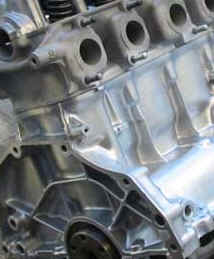 Some of the considerations that you should keep
in mind before building a competitive performance engine are the usage.
What I mean is a highway car would be a better candidate then a stop and
go city car as the steady driving on the highway is less stressful on the
engines internal components. Check the condition of the oil for good signs
of being dark or black in a liquid type form, signs of congealed,
gooey-looking oil, sludge or dry looking flakes of oil residue indicates a
poor maintenance schedule. Definite signs of rebuilding include signs of
blue smoke or excessive oil consumption, internal noises such as
lower end knocking or pounding could be signs of bad main bearing or
connecting rod bearing. Some of the considerations that you should keep
in mind before building a competitive performance engine are the usage.
What I mean is a highway car would be a better candidate then a stop and
go city car as the steady driving on the highway is less stressful on the
engines internal components. Check the condition of the oil for good signs
of being dark or black in a liquid type form, signs of congealed,
gooey-looking oil, sludge or dry looking flakes of oil residue indicates a
poor maintenance schedule. Definite signs of rebuilding include signs of
blue smoke or excessive oil consumption, internal noises such as
lower end knocking or pounding could be signs of bad main bearing or
connecting rod bearing.
|
|
Connecting Rods
|
|
Heat treating your connecting rods will help
prevent bending and shot-peening to help prevent cracking would be good
advise for the professional or serious racer. However according to Jackson
Racing Honda stock rods are reliable.
|
|
Crankshaft
|
|
Improved acceleration can be obtained by
lightening the crank shaft (approx 2lbs) by reshaping the counter weights
down to knife like shapes allowing it to slice through the oil in the
crank case with little resistance. Of course the crank will have to
be rebalanced after this procedure.
|
|
Block
|
|
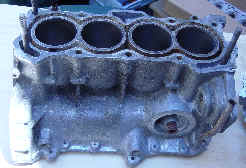
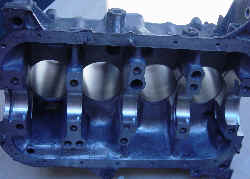 Before you start make sure the block is not
cracked and the deck should be flat, the cylinder should not be scored or
show signs of spun bearings. Most Hondas can be bored and honed up to
0.040 in. oversize. An EB3 head with its pistons can be used on the EB2
block to give a higher compression ratio. Before you start make sure the block is not
cracked and the deck should be flat, the cylinder should not be scored or
show signs of spun bearings. Most Hondas can be bored and honed up to
0.040 in. oversize. An EB3 head with its pistons can be used on the EB2
block to give a higher compression ratio.
|
|
Pistons
|
|
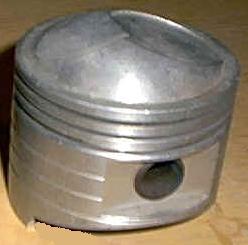 Forged high compression pistons would be a good
addition, but you will have to get them custom made. Over sized pistons in
the EB3 size can be difficult to find and chances are you will me making a
call to places like Viola
to have a set made up to your specs. A lighter weight piston will raise
the RPM limit as well as having one that is designed for higher
compression ratio. Lowering the compression ratio has the advantage in turbo charging
system allowing a higher boost level.
Forged high compression pistons would be a good
addition, but you will have to get them custom made. Over sized pistons in
the EB3 size can be difficult to find and chances are you will me making a
call to places like Viola
to have a set made up to your specs. A lighter weight piston will raise
the RPM limit as well as having one that is designed for higher
compression ratio. Lowering the compression ratio has the advantage in turbo charging
system allowing a higher boost level.
Lemeke:
The pistons I use are for a 73mm bore... but please understand that the piston mfr. will determine the diameter of the piston and the clearance requirements. A high performance forged piston will rarely be the same diameter from dome to skirt, there is usually a bit of a taper due to thermal mass expansion. I use
Venolia's, and they are a great piston. The Honda Goldwing rings for these pistons, however, are no longer made. Total Seal has a ring set available, part#6116.040.91-04. This is assuming a 1.5mm top and middle ring, and a 2.5mm oil control ring.
|
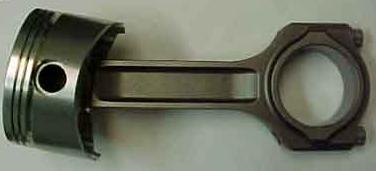 Crower rod and Venolia piston. The rods weigh 32g heavier than stock
Crower rod and Venolia piston. The rods weigh 32g heavier than stock
|
|
1300 Rods versus 1200 rods w/Venolia Pistons
|
|
The 1300 has a shorter rod than the 1200, that's how std pistons work with the
EJ/EN crank and rods.
The 1300 rod ratio is not as good as the 1200, so installing the 1200 rod helps to make up for it. It will still never be as good as the 1200 though because of the stroke increase. Rod ratio and such has no effect on compression. The 3mm is half of the stroke. That's what needs to happen if you use the 1200 rod on the 1300 crank. The rings being smaller almost makes up for the shorter compression height (piston pin height).
there is somewhat a rule of the thumb for rod ratios. There are many variables though, such as cylinder head design, max rpm's, camshaft design, etc. You need to have some engineering background to comprehend such things though. So let's just stick to the basics.
As far as the valve to piston clearance, it will not be a concern on the 1300 crank, because it will never have as good of a ratio as the 1200. My only point in doing this is because the 1300 has a shitty rod ratio.......IMO. I build a bunch of engines........
If you use a 1300 crank (6mm longer stroke), a 1200 rod (3mm longer than a 1300), You HAVE to move the piston pin up in the piston 3mm. I told you about the 1300 ring set because it gives you more room to move the pin up without stacking the rings to tight.
Bryan
|
|
1980-1983 1335cc Civic Engine Swap
|
|
A simple swap for the 1237cc engine is the use
of the crank shaft, connecting rods and flywheel from a 1980-1983
1335cc Civic. With this combination you can create a 1335cc with a
cross-flow cylinder head. The 1335 uses a CVCC head that makes less power.
The 1335 crank has a 82mm stroke while the 1237cc has a shorter stroke of
76mm. The 1335 connecting rods are shorter to compensate for the
difference while the 1335 flywheel is used because the 1335 crank flange
uses a dowel pin and the 1237 engine does not.
Installation based on Dr Zoom
This is a complete bolt in as if it was the original replacement. You need the crank, and the 1335 rods witch are shorter to compensate for the longer crank swing. The bearings are the same as the 1200`s. I used the select fit ones from Honda and ordered the main bearings from an EB3 and ordered the select fit rod bearings from an EN1. The 1200`s wrist pins are the same and will fit into the new 1335 rods. The front and back crank oil seals are the same as the 1200`s too.
There is a clearance problem on certain models of blocks. I personally didn't have this problem but I have heard of it. Its simple to repair. The clearance problem is in between the bottom of the new rods and the
aluminum main bearing girdle in the 1200`s block. The new longer crank swing takes the new rods real close to the girdle and in some blocks it might touch/bump into the girdle. All you have to do is grind/file out a space for it to pass and your done. Mine passes with 1-2mm to spare. This clearance problem might be a difference between certain castings of the block or a EB1, EB2 problem. Mine is an EB3 and I didn't have this problem.
I have heard of having to use the 1335 flywheel? My EB3 1200 flywheel was the exact same as the 1335 one so I used it.
|
|
Honda Goldwing Stroking Motor
|
|
1300 crank and rods, the EB2 head, Goldwing pistons..." Not the best combination unless you run very high octane fuel (as Charles R. said) as you will have a very high compression ratio. I can't tell you exactly, but I would guess around 12:1. 1300 bottom end with an EB3 head, skimmed a couple of mm, and Goldwing pistons will give a nice useable
compression ratio or around 10:1.
1300 pieces needed: Crank, rods, sump and oil pump (slightly more volume than EB pump, Datsun has one that is the same- canít remember which one)
You gain about a liter of oil capacity with an EN1 sump. It just bolts on with an EB2/3 or EN gasket (early EB1 baskets don't have all the holes in them). You do need to do a tiny bit of clearance at the flywheel end where the sump sits above the lower engine mount (it touches the mount) - fixed with a couple of thumps with a hammer. No idea if EJ sump = EN sump, someone else will have to answer that.
You also want to put in an EN oil pump as it has a longer pickup for the slightly deeper sump.
You loose no significant ground clearance (maybe 10mm, but can't remember exactly)
Installation based on Dr Zoom, How to install the Honda Goldwing motorcycle higher compression pistons.
Since the cost of a stock piston from a Honda car dealer and the cost of a Goldwing piston from a motorcycle dealer are the same, it only makes since. The Goldwing piston will give you the compression bump you need to make that extra power you want. The Goldwing pistons start off in the same size as the stock 1200 piston (EB3). 72mm. They are also available in the same over sizes too, 0.25mm, 0.50mm, 0.75mm and 1.00mm. Just order the size you want and the Goldwing rings to match. I ordered 1979 Goldwing parts.
The pistons fit perfectly and the Civic 1200`s wrist pins, 1335 wrist pins and the Goldwing`s wrist pins are all the same. You can order witch ever model you want. There is only one clearance issue to do first to the pistons. The Goldwing motorcycle has a skinnier/thinner rod end up top due to the lower crank swing in that motor, so the piston is cast with meatier wrist pin bosses. The 1200 rods and 1335 rods are fatter/thicker up top in comparison to the Goldwing rod due to their longer swing. They need the added strength.
What you have to do is have a machinist remove some of this aluminum in between the meatier wrist pin bosses of the Goldwing piston in order to get lateral clearance in between the wrist pin bosses and the Civic rods. Its not much to remove and I paid $40.00 can. to have it done to all 4. It has to be done right because it will unbalance the piston / pistons if not. Once this clearance is done, your ready to install them on your Civic rods and go play.
|
|
|
|
 |
 |
 |
 |
|
 |

